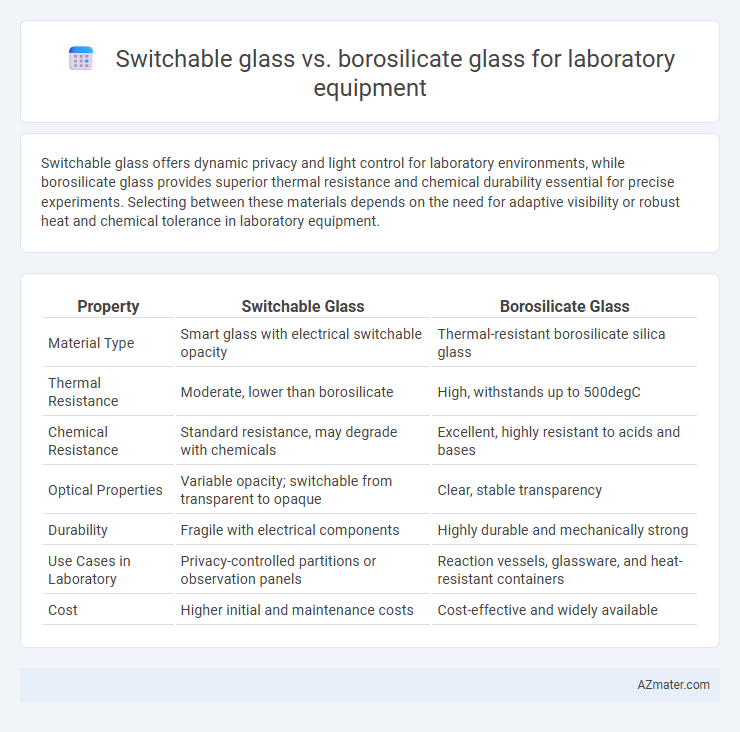Switchable glass offers dynamic privacy and light control for laboratory environments, while borosilicate glass provides superior thermal resistance and chemical durability essential for precise experiments. Selecting between these materials depends on the need for adaptive visibility or robust heat and chemical tolerance in laboratory equipment.
Table of Comparison
| Property | Switchable Glass | Borosilicate Glass |
|---|---|---|
| Material Type | Smart glass with electrical switchable opacity | Thermal-resistant borosilicate silica glass |
| Thermal Resistance | Moderate, lower than borosilicate | High, withstands up to 500degC |
| Chemical Resistance | Standard resistance, may degrade with chemicals | Excellent, highly resistant to acids and bases |
| Optical Properties | Variable opacity; switchable from transparent to opaque | Clear, stable transparency |
| Durability | Fragile with electrical components | Highly durable and mechanically strong |
| Use Cases in Laboratory | Privacy-controlled partitions or observation panels | Reaction vessels, glassware, and heat-resistant containers |
| Cost | Higher initial and maintenance costs | Cost-effective and widely available |
Introduction to Switchable and Borosilicate Glass in Laboratories
Switchable glass in laboratories offers dynamic control over light transmission, enabling instant transition between transparent and opaque states to enhance privacy and light management. Borosilicate glass, renowned for its exceptional thermal resistance and chemical durability, remains a staple in laboratory equipment such as beakers and test tubes due to its ability to withstand high temperatures and corrosive substances. While borosilicate glass excels in structural reliability for experiments, switchable glass introduces innovative functionality by optimizing environmental conditions within laboratory spaces.
Defining Switchable Glass: Technology and Applications
Switchable glass, also known as smart glass, utilizes electrochromic or PDLC (polymer dispersed liquid crystal) technology to change its opacity or transparency with an electric current, enhancing privacy and light control in laboratory settings. This advanced material enables instant modulation between clear and frosted states, optimizing visual access and contamination prevention during sensitive experiments. Compared to borosilicate glass, which is prized for its thermal resistance and chemical durability, switchable glass offers dynamic functionality that supports innovative laboratory design and workflow efficiency.
Overview of Borosilicate Glass: Properties and Uses
Borosilicate glass is distinguished by its exceptional thermal resistance, low coefficient of expansion, and high chemical durability, making it ideal for laboratory equipment exposed to rapid temperature changes and corrosive substances. Its composition, primarily silica and boron trioxide, grants resistance to thermal shock and chemical attack, essential for precise scientific experiments and reactions. Common uses include beakers, flasks, and test tubes, where reliability and safety in high-heat and chemically aggressive environments are critical.
Chemical Resistance: Switchable vs Borosilicate Glass
Borosilicate glass exhibits superior chemical resistance, withstanding strong acids, alkalis, and organic solvents, making it ideal for most laboratory applications involving harsh chemicals. Switchable glass, primarily designed for privacy and light control, lacks the extensive chemical resistance of borosilicate glass and may degrade or lose functionality when exposed to aggressive chemicals. Choosing borosilicate glass ensures durability and safety in chemical-intensive laboratory environments.
Thermal Stability and Performance Comparison
Switchable glass offers dynamic control over light transmission but has lower thermal stability compared to borosilicate glass, which withstands temperatures up to 450degC without deforming or cracking. Borosilicate glass is preferred for laboratory equipment requiring high thermal shock resistance and chemical durability, ensuring consistent performance during rapid temperature changes. Switchable glass is more suitable for applications needing adjustable opacity, while borosilicate glass excels in environments demanding superior thermal performance and structural integrity.
Optical Properties and Transparency Differences
Switchable glass offers dynamic control over light transmission, allowing users to adjust transparency and opacity as needed, which enhances privacy and light management in laboratory settings. Borosilicate glass provides exceptional optical clarity with high transparency and minimal distortion, ideal for precise visual observations and accurate measurements. While switchable glass introduces versatile light modulation, borosilicate glass maintains superior optical purity and consistent visibility under various laboratory conditions.
Durability and Mechanical Strength Analysis
Switchable glass offers moderate durability but lacks the high mechanical strength characteristic of borosilicate glass, which is renowned for its exceptional thermal resistance and resistance to mechanical stress. Borosilicate glass maintains structural integrity under extreme temperature fluctuations and chemical exposure, making it ideal for demanding laboratory applications requiring robust durability. In contrast, switchable glass, primarily used for its electrochromic properties, may be more susceptible to scratches and impact, limiting its use where mechanical strength and long-term durability are critical.
Cost Implications for Laboratory Equipment
Switchable glass generally incurs higher initial costs compared to borosilicate glass due to its advanced electrochromic technology and integration complexity. Borosilicate glass remains cost-effective, offering durability and chemical resistance essential for most laboratory applications. Laboratories prioritizing budget constraints often choose borosilicate glass, while switchable glass suits specialized settings requiring dynamic transparency despite increased expenses.
Suitability for Specific Laboratory Applications
Switchable glass offers dynamic control over light transmission, making it ideal for laboratory environments requiring adjustable privacy or controlled light exposure, such as in microscopy or cell culture rooms. Borosilicate glass excels in thermal and chemical resistance, making it suitable for high-temperature reactions, chemical storage, and handling aggressive solvents in laboratories. The choice depends on whether the application prioritizes optical modulation or durability under extreme laboratory conditions.
Conclusion: Selecting the Right Glass for Your Laboratory Needs
Switchable glass offers dynamic opacity control, ideal for laboratories requiring privacy and adjustable light transmission, while borosilicate glass provides exceptional thermal resistance and chemical durability, essential for high-temperature and corrosive experiments. Choosing between switchable and borosilicate glass depends on specific lab applications, with switchable glass enhancing environmental control and borosilicate ensuring safety and reliability under harsh conditions. Prioritize borosilicate glass for durability in rigorous chemical processes and switchable glass when flexible visibility and energy efficiency are critical.

Infographic: Switchable glass vs Borosilicate glass for Laboratory equipment
 azmater.com
azmater.com